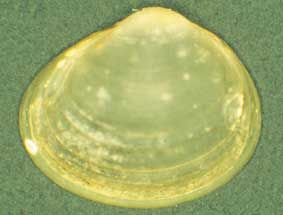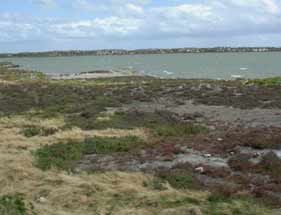Major Group: Bivalvia
Order: Pholadida (previously in Veneroida)
Family: Sphaeriidae
|
Descriptive Features: outline of shell subquadrangular, beaks prominent, sometimes with a well marked embryonic or nepionic cap, median and slightly prosogyrous
posterior margin subtruncate, anterior narrower, attenuate
upper margin less rounded than lower margin
shell, thin, fragile, subtransparent, greyish, often with 1 or more growth ridges and darker concentric zones
sculpture very fine, irregular concentric lines (20-24 per ½ mm), dull shining, beaks nearly smooth
ligament visible exteriorly, protruding in full grown specimens
ligament pit very narrow and relatively long, about 1/5 of the shell-length, at its inside bordered by a ridge
hinge extremely narrow in its central part
cardinal teeth of left valve very small, straight, short, C2 above and behind C4; cardinal tooth of right valve, C3, 2X long as left cardinals, thickened at its posterior end, lateral teeth of left valve, A2 and P2, as well as those of right valve, AI, A3, P1 and P3, very narrow with long inner slopes
Size: length 9 mm, height 7.5 mm, diameter 5 mm
|

|
Musculium tasmanicum |
|
|
|
Taxonomic Checklist: Genera
Musculium (previously Sphaerium)
Pisidium
|
|
Distribution: ACT, SA, Vic, NSW, Tas, Qld, SW WA
Sensitivity Rating: SIGNAL grade 5
Functional Feeding Group: filtering collectors |

|
Murray River estuarine, Hindmarsh Island SA |
|
|
Ecology: Instream habitat: Sphaeriidae species usually occur in large numbers in many types of still or flowing permanent or semi-permanent waters from mountain bogs above the snow line to lowland rivers and freshwater pools in desert areas. Sphaeriid mussels are found in mud, sand and gravel.
Feeding ecology: Bivalvia species are filter feeders that feed by leaving the hind portion of the shell exposed to the water column, to allow a pair of siphons to pump water into the shell where food is absorbed and then wastes expelled. They are not selective, feeding opportunistically on unicellular algae and plant detritus suspended in the water. Bivalvia can play a significant role in local food webs by increasing the flux of organic and inorganic matter to riverbeds, which in turn influences macroinvertebrate assemblages.
Habit: Sphaeriidae species burrow into the substratum.
Life history: Sphaeriid eggs are small, about 0.05mm in diameter. Adults are hermaphrodites and brood their young in pouches in their gills (marsupia). Sphaeriidae species undertake prolonged parental care, releasing their young from the marsupia into the water as crawl away juveniles.
|
| |
Information Sources: Korniushin 2000, Kuiper 1983, Smith 1996, Smith 1992, 2003, Korniushin & Glaubrecht 2006, Park & Ó Foighil 2000, Sloane & Norris 2002, Bouchet et al. 2010
Key to Genera: Korniushin 2000
Key to Species: Korniushin 2000
|
|
|
|